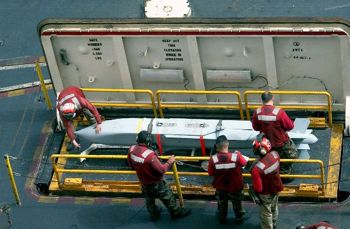AGM-154 Joint Standoff Weapon
 From Citizendium - Reading time: 3 min
From Citizendium - Reading time: 3 min
| This article may be deleted soon. | ||
|---|---|---|
The AGM-154 Joint Standoff Weapon (JSOW), known as the "flying pig" after the last three letters of its acronym, is a long-range guided bomb developed by the United States Navy and used by the other U.S. air services and a wide range of foreign operators. Guided bombs are unpowered precision-guided munitions.[1] Powered version are in testing, possibly putting it into competition with some guided missiles. For example, the C1 version has an anti-shipping missile; combined with the engine from the extended range version, it would have greater range than the AGM-84 Harpoon. On the other hand, the Harpoon may be cheaper. The JSOW is more expensive, but has longer range and more extensive options, than the other main U.S. guided bomb, the Joint Direct Attack Munition (JDAM).
In 2005, the United States Air Force stopped procuring JSOws in favor of other weapons, but have become involved again in newer models. The weapon connects to standard MIL-STD-1553/MIL-STD-1760 (also NATO STANAG 3837) electronic interfaces, and could, in principle, be used by any aircraft with them. "In principle" means that it still has to be tested to verify that it can be dropped from the aircraft, without mechanical compatibility or aerodynamic problems. It is now qualified for use on the United States Air Force F-16 Fighting Falcon, F-15E Strike Eagle and B-52; the F-35 Joint Strike Fighter and the U.S. Navy F-18 Hornet, and P-3 Orion. Operational types[edit]The JSOW family currently consists of four weapon variants. Baseline[edit]AGM-154A JSOWs are cluster munitions that carry 145 BLU-97 dual-purpose submunitions(i.e., effective against people, and lightly armored vehicles. It is especially effective against spread-out targets such as airfields and air defense sites. Over 400 AGM-154As have been used in combat in Afghanistan and Iraq. These are no longer produced. Unitary penetrating warhead[edit]A modified version of the AGM-154A, termed AGM-154A-1, replaces the cluster munition (and submunitions) with a BLU-111, which is a 500-pound bomb with a hard steel case to penetrate underground or reinforced targets. Anti-armor cluster submunitions[edit]The AGM-154B is a different kind of cluster munition, not designed for antipersonnel effects, which has six BLU-108B/B canisters, each of which release 4 anti-tank submunitions that can defeat much heavier armor than a dual-purpose bomblet. While development is complete, production has not started, probably due to the lack of plausible enemies with large numbers of tanks. Unitary blast-fragmentation warhead[edit]While both the AGM-154B and AGM-154C variant carry 500-pound bombs, the -C version is a thin case without a significant penetrating capability, doing its damage by blast and fragmentation. Thin-case bombs have more space for explosive payload. The C-model has additional guidance, in the form of an uncooled, long-wave imaging infrared seeker with autonomous target seeking. It became operational in February 2005. Future[edit]C1 upgrade[edit]The AGM-154C-1 variant, scheduled to be operational in Fiscal Year 2010, will have a seeker capable of finding and hitting moving targets at sea. In March 2009, Raytheon received an upgrade contract for the C1, which has a two-way date link and can attack moving targets. [2] Extended Range[edit]By adding a small jet engine from the Raytheon Miniature Air Launched Decoy (MALD), a JSOW version, with aerodynamics and ballistics identical to the others and using the same control systems, was tested in 2008, on a C1-model. [3] This will give it approximately 300 mile range. References[edit]
|
||
 KSF
KSF